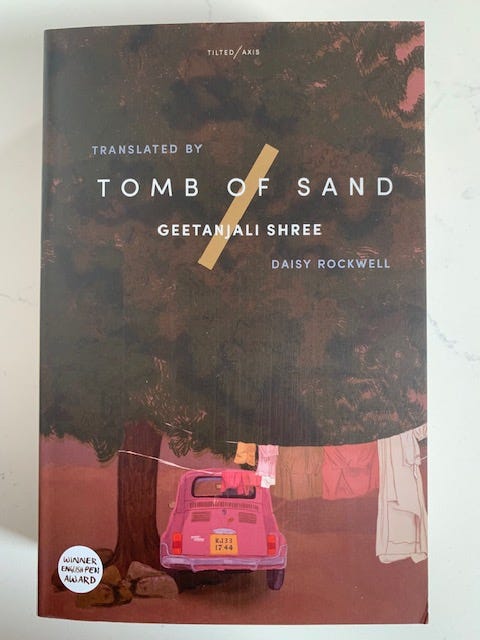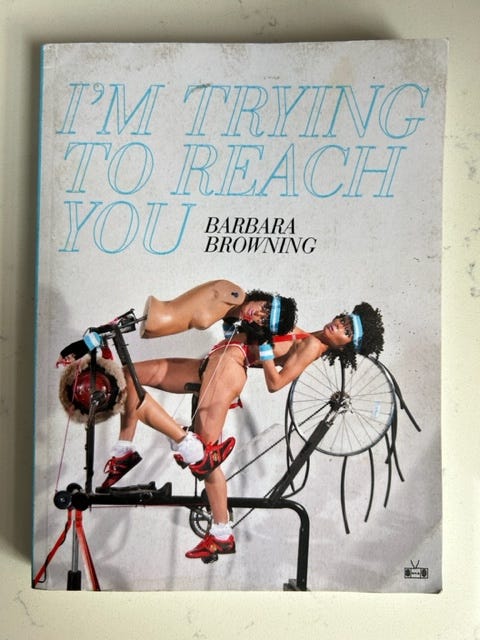'Tomb of Sand' by Geetanjali Shree
'What do you think, she asked, that relationships, love, only got invented after your generation showed up?'—Review #197

It’s hellish right now, I know. There’s an election this week, it’s getting dark early, and Twitter is imploding. The sad season is upon us, and last week I was feeling down big time. To get out of this funk, Donna and I went to Montauk for the weekend to listen to the ocean, recharge our batteries and eat delicious bone-in pork chop parm. I packed Geetanjali Shree’s ‘Tomb of Sand,’ which won this year’s International Booker Prize, for the trip. I had heard good things about it, and I wanted to take a book long enough for the train rides out and back. Somewhere between Babylon and Speonk, I remembered this novel is not yet widely available in the United States. But it’s coming soon and is something you should look forward to in brighter days.
Here’s the cover:

‘Tomb of Sand’ opens with its roughly 80-year-old protagonist, Ma, bedridden in grief following the death of her husband. She lays facing the bedroom wall, her back turned to the world and her family, including Bade (her son), Beti (her daughter), Bahu (her daughter-in-law), and grandsons Sid and Overseas Son. Ma’s family wants to draw her out of bed and back into the swing of life. There’s a deadline, as the family is moving to a new home in Delhi. Sid tries witty banter to revive his grandmother. Overseas Son, who lives in Australia, sends gifts including a collapsable cane decorated with butterflies. One day, Ma’s old friend Rosie visits. Rosie is a hijra, which I Googled and learned refers to non-binary, third gender people in South Asia. Shortly thereafter, Ma goes missing. Everyone’s like:

Ma eventually is found, but doesn’t divulge where she’s been. She moves in with Beti. The change of scenery will do her good, the family believes, and will keep her out of the way during the move. Beti styles herself a modern woman, practically bohemian, who shuns traditions. She’s divorced, lives alone and works as a freelance writer. Her mother’s presence, however, throws her life and her identity into upheaval as she’s forced into an unfamiliar caretaker role, stressing over her mother’s every move. Also unsettling is the continuing presence of Rosie. Beti wonders, with a touch of resentment, why her mother is close to a hijra. What are they up to during their hours together? Will this connection hurt Ma? Turns out, Rosie has a secret. It compels Ma to embark on a perilous physical and emotional journey, with Beti and the butterfly cane in tow. Long-buried memories going back to the partition of India and Pakistan are unearthed and reckoned with. I won’t spoil it here, but the outcome had me like:

Shree’s narrative meanders (a perfect description I’m stealing from my newsletter friend, Resh), and for hundreds of pages I had no idea what the story was about. I first thought it might be about depression and old age. After a scene were Bahu stops to instruct the maid and gardener amid her rush to the police station where Ma has turned up, however, I thought it might be a critique of middle-class bourgeois behavior. But then Shree gives human aspects to inanimate objects—doors, walls and trees have memories, flags are mischievous. What’s that about? And how does it square with the crows, who pop up to observe events and at one point hold a convention outside Beti’s apartment? Is it about the importance of place—whether a home, or the land, or its creatures—to our own memories? Once we get to the final act, we see the book is about all this and more, and all the meandering fits together and builds toward a central theme about borders, and how:
Ma’s story shows that borders—whether lines on a map, differences in generations or prejudices about people—are arbitrary and meant to be overcome. It’s a powerful message delivered in a beautiful way. Still, this book isn’t for everyone. Its style makes it hard to follow at times, and the absence of quotation marks doesn’t help. But these are minor quibbles. I learned a lot from ‘Tomb of Sand,’ and I’m glad I read it. If you’re up for a challenging, insightful and rewarding read, I highly recommend it. Keep an eye out for it in 2023!
How it begins:
A tale tells itself. It can be complete, but also incomplete, the way all tales are. This particular tale has a border and women who come and go as they please. Once you’ve got women and a border, a story can write itself. Even women on their own are enough. Women are stories in themselves, full of stirrings and whisperings that float on the wind, that bend with each blade of grass. The setting sun gathers fragments of tales and fashions them into glowing lanterns that hang suspended from clouds. These too will join our story. The story’s path unfurls, not knowing where it will stop, tacking to the right and left, twisting and turning, allowing anything and everything to join in the narration. It will emerge from within a volcano, swelling silently as the past boils forth into the present, bringing steam, embers, and smoke.
There are two women in this story. Besides these women, there are others who came and went, those who kept coming and going, those who always stayed but weren’t as important, and those yet to be mentioned, who weren’t women at all. For now, let’s just say that two women were important, and of these, one was growing smaller, and the other bigger.
There were two women and one death.
Who they thanked:
Translator Daisy Rockwell—in addition to thanking the author, her agent, her husband, daughter, and her family and friends—thanked her cats. They are named Jenny Linski, Madama Butterfly and Princess Leia. I love this, not just because one cat is named after a ‘Star Wars’ character. Our cat, Lola, has been an integral part of our Books on GIF team as a purring reading companion and model for our promotional book marks. It’s always good to thank your pets!
My rating:

‘Tomb of Sand’ by Geetanjali Shree was published by Rajkamal Prakashan in 2018, and by Tilted Axis Press in 2021. Translated from the Hindi by Daisy Rockwell. 735 pages. Preorder at Bookshop.org for $27.89.
What’s next:
Before you go:
ICYMI: Review #196
Read this: Molly Young and I share the same favorite Philip K. Dick novel: ‘Ubik.’ I always recommend it to folks wanting to get into the sci-fi legend’s work, and so does she in this excellent roundup for The New York Times. Young is one of my favorite book reviewers. I mean, how can you not love this line about our cherished ‘Ubik’: ‘The novel’s themes of entropy and delusion will swirl in your subconscious like a malevolent cone of soft serve.’
See this: The late, great Joan Didion’s estate sale is coming up later this month. Online bidding is open. You can browse the lots here. A pair of her Celine sunglasses is currently going for more than $3,000. A framed photograph from the iconic series of images with Didion and her Corvette is going for $6,000.
Thanks for reading, and thanks especially to Donna for editing this newsletter!
Until next time,

MPV








I thank the Heaven’s for Lola and her support of BOG. Also, excellent gifs. 👌🏼
Two things:
1. This is one of many reasons why I love this newsletter. I never would've considered this book if it weren't for your thoughtful review. Thank you.
2. More cat content in the future, please!!!